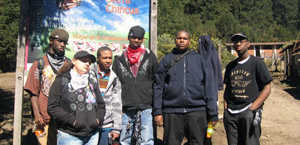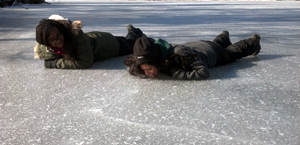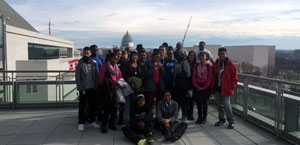Blog: 2015
"Adding wings to caterpillars does not create butterflies it creates awkward and dysfunctional caterpillars. Butterflies are created through transformation." Stephanie Pace Marshall.
For the Monarch butterfly, lasting transformation also requires a journey.
A new school year begins at the UrbanPromise Academy (UPA) but not without our Freshman Orientation-- two days at North Bay Adventures on the Upper Chesapeake. North Bay is an outdoor center with team building and challenge activities from kayaking to zip lines and low ropes. All the activities are designed to challenge and build team work for the participants.
At the Academy we use this opportunity for students and teachers to get to know each other before entering the rigors of the formal classroom. Our students are introduced to the values of UrbanPromise and the many opportunities in and outside of the classroom. Zip lines and challenge activities reveal much about individual character traits when under positive stress. The groups dynamics also tell us a great deal about how the new students will work together to problem solve and think critically individually and collectively.
But now I have a confession: I think I'm getting too old for another class of freshman. Will they ever make it? Or perhaps the better question is: will I ever make it? Thirteen and fourteen year old teens, these kids were born in the twenty-first century! But after a few hours with this group, I realize I've been here before. I've wondered this every year since I've been leading our Freshman Orientations.
After returning from our orientation I decide to stop by my office to check on messages before heading home for the weekend and some much needed rest. As I'm sitting at my desk checking my messages, into the office walks Chris Williams, one of my alum from the class of 2011. Chris is heading back to Rutgers New Brunswick over the weekend to complete his final semester before a December graduation and hopes of law school.

Oh, to have known Chris as an Academy freshman you wouldn't have thought he'd ever make it. He'd want to argue with you even if you simply said good morning-- he'd find reasons to rate it as just fair.
When Chris was a sophomore at UPA, we had an elective class called Journeys, a study of the life cycle and migration of the Monarch Butterfly. We were blessed to be able to travel to see the wintering sanctuaries in the Trans-Volcanic Mountains of Michoacán, Mexico. Most butterflies live only a matter of weeks, as do many generations of the Monarch, except for those that emerge from their chrysalis in late summer. For them, there must be the journey in order for the butterfly to reproduce in early spring and for the future generati
ons to begin the journey north. Nature taught us that without this journey of thousands of miles, transformation for the Monarch Butterfly would be fleeting. Chris’ visit to my office was perfectly timed. Reflecting on his journey and transformation reminds me of this necessary step and renewed my inspiration for this year and freshman classes to come.
Keep on Trekkin’,
Jim
The ice groaned. I had my Trekker student leaders out for a mid-January late night walk along the trail to Catfish Pond in the Delaware Water Gap where the Appalachian Trail cuts through New Jersey. The temperature outside the cabin door read 17 degrees. No wind made for a clear, crisp night where we could see the Milky Way. Students were challenged to be silent as we hiked single file along the icy path.
We could only hear the sounds our boots made as they crunched the ice and frozen snow under our feet. After a short while, we approached the pond, one of the southernmost glacial lakes carved out during the last ice age that created the geography of the Appalachian Mountains in New Jersey.
 The lake surface was a solid sheet of ice floating on top of the water. To my amazement, not one of my ten students or two young staff members had ever set foot on a frozen lake. They were all in awe as we stepped out cautiously onto the icy surface.
The lake surface was a solid sheet of ice floating on top of the water. To my amazement, not one of my ten students or two young staff members had ever set foot on a frozen lake. They were all in awe as we stepped out cautiously onto the icy surface.
Soon the sounds of the ice creaking echoed into the still night. My Trekkers were concerned: "Mr. C, it sounds like there are animals trapped under the ice." "What are those sounds?" After a while, though, confidence grew. Students felt safe. Now was a time to explore not only the surface and the sounds, but how we might play on this glass-like field.
First off, I had everyone lie down on the ice, put their ears to the cold surface, and listen. They heard the hidden waters sloshing under the solid ice surface and listened to the sounds of ice expanding and constricting from the changes in temperature. We began a game of human shuffleboard- sliding one another across the frictionless surface. A competition was inevitably created with all the girls sitting in a tucked position and in their individual lanes with the boys pushing them to see who could slide the furthest.
We were silly and childlike, making up our games as we played under the stars on a frigid night. We were far from the city. We were all children once again. I loved it.
Keep on Trekking,
Jim Cummings
Director of Experiential Learning
What comes to mind when you think of a fifteen year old kid? Some people laugh, remembering what they were like at 15. Others think of their own children at that age and the struggles they went through. Many, especially those who aren’t around fifteen year old kids on a regular basis, roll their eyes, recalling stories of an annoying kid that was being too loud, making awkward conversation, or being rude to them in a store, intentionally or unintentionally.
Over the Christmas break, the UrbanTrekkers staff (and one brave volunteer) took 20 students to Washington, D.C. for four days of exploring our nation’s capital. For many of these students, this was their first Trekker trip. The freshman class at the UrbanPromise Academy was well represented, which is a wonderful  indication of the involvement of students in Trekkers. This large group of younger students, however, also meant four days of waiting for them to be quiet before starting a group discussion, asking the same boys to think before they act over and over again, girls with attitudes, and several apologies to other tourists for the behavior of these students. Like, maybe it’s not a great idea to do pull-ups on the doorway of a food court at a museum. Just a thought.
indication of the involvement of students in Trekkers. This large group of younger students, however, also meant four days of waiting for them to be quiet before starting a group discussion, asking the same boys to think before they act over and over again, girls with attitudes, and several apologies to other tourists for the behavior of these students. Like, maybe it’s not a great idea to do pull-ups on the doorway of a food court at a museum. Just a thought.
On our annual trip to Washington, D.C. a favorite destination of the students is the Holocaust Museum. Something about that place grips students beyond any other site. The night before we go there, we have the older students prep the younger group-telling them to be respectful, quiet, and attentive in a place that memorializes those lost in such a global tragedy.
The visit to the Holocaust Museum with students is also my favorite, but not necessarily because of the place itself. This year, in the midst of rambunctious freshmen boys and disinterested freshmen girls, the Holocaust Museum was the one place where all of our nagging stopped. The kids got it. Those same freshmen boys who had been a pain all week were following the seniors, reading everything. Those freshmen girls who we had dragged around for three days (despite their aching feet) stayed close to their English teacher, learning and allowing themselves to feel the weight of the pictures they were seeing.
Back at our hostel that night, I asked the students a simple question: “How does the Holocaust, which happened 70 years ago, affect us and current events around us today?” A freshman boy, Carlos, was among those who answered. He said this: “The Holocaust is a story of people with power influencing those around them to forget other people’s humanity. This is still happening. It happened to Eric Garner; it’s happening in Syria. We have to remember that this happens all the time, and it should be our responsibility to do something about it.”
When Carlos said that, I’m fairly certain my jaw hit the floor. This was the same kid who had just finished telling me that his highlight of the week was running up a down escalator at Union Station. A fifteen-year-old kid, who many adults write off as a pain in the neck until he grows up, allowed himself to learn and be deeply affected by what he saw. That doesn’t always happen, but because Carlos had the opportunity to go on the Trekker trip, he was able to make those kinds of inferences. Statements like Carlos’ are why I love trekking.
Keep on trekkin',
Julia

